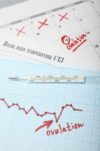Cycle Tracking Basics
A healthy period often means healthy hormones and healthy fertility. To know if you have a healthy period, you need information. So, lets gather some data. The first step in understanding your hormonal and fertility issues is getting to know your body. As a menstruator getting to know your body means bringing awareness to your cycle and the phases that your body is going through (or not going through) monthly.
Today we are diving into menstrual cycle tracking to help you get to know your body.
The basics of tracking your cycle
- Mark down Day 1 of your cycle. Day 1 of your cycle is the first full day that you bleed red blood.
- Note how many days you bleed and whether the flow is heavy, moderate, or light.
- Make a note of any cramping, breast tenderness, fatigue, clots, headaches, or anything else that seems linked to your period.
- Notice when you begin to see signs of ovulation such as an increase in cervical mucous. Make a note of those days as well as which day is your peak day (peak day is the day you have the most abundant cervical mucous).
- Note any changes throughout your cycle. It all matters: mood changes, energy changes, cramps, discharge changes, changes in heaviness of flow. Write this down.
- As you track this all for a few months you will start to see patterns. Learn what your normal is.
The information you gather can help your naturopathic doctor figure out where any issues may lie.
Ready to take it to the next level?

Basal Body Temperature Charting
This is a wonderful way to get a deeper understanding of your menstrual cycle.
Take your temperature daily and follow these basic guidelines
- Take it immediately upon waking in the morning.
- Ensure that you were asleep for at least 3 hours
- Take it at the same time each day. **
** If you must choose between #2 and #3, choose #2. For example, if you wake up to pee at 5am but usually you take your temperature at 6:30am, take your temperature at 5am before you get up to pee.

There are many apps that can be used to track this, but it can also be done the old-fashioned way. Below is a link to a PDF of a basal body temperature chart that I use that can help get you started, courtesy of Toni Weschler (Author of Taking charge of your fertility).
Basal Body Temperature – Celsius
Basal Body Temperature – Fahrenheit
My most recommended resource for cycle tracking is Toni Weschler’s book ‘Taking Charge of your Fertility”. (No affiliation) I have three copies in my office that I lend out to patients so they can check it out before they purchase it. In my opinion this book should be required reading in health class in high school. Everyone menstruator needs to read it and understand their body.
So here we go! You are one step closer to figuring you what your body needs to optimize fertility and balance your hormones.


